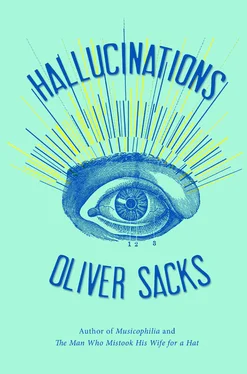In the early 1960s, sensory deprivation tanks were designed to intensify the effect of isolation by floating the body in a darkened tank of warm water, which removed not only any sense of bodily contact with the environment but also the proprioceptive sense of the body’s position and even its existence. Such immersion chambers could produce “altered states” much more profound than those described in the original experiments. At the time, such sensory deprivation tanks were sought out as avidly as (and sometimes combined with) “consciousness-expanding” drugs, which were more widely available then. 13 13 While the romantic use of sensory deprivation, as that of vision-producing drugs, has diminished since the 1960s, its political use is still horrifyingly common in the treatment of prisoners. In a 1984 paper on “hostage hallucinations,” Ronald K. Siegel pointed out that such hallucinations can be magnified sometimes to madness, especially when combined with social isolation, sleep deprivation, hunger, thirst, torture, or the threat of death.
There was a great deal of research on sensory deprivation in the 1950s and 1960s (a 1969 book edited by Zubek entitled Sensory Deprivation: Fifteen Years of Research listed thirteen hundred references) — but then scientific interest, like popular interest, started to peter out, and there was relatively little research until the recent work of Alvaro Pascual-Leone and his colleagues (Merabet et al.), who designed a study to isolate the effects of pure visual deprivation. Their subjects, though blindfolded, were able to move around freely and “watch” TV, listen to music, walk outside, and talk to others. They experienced none of the somnolence, boredom, or restlessness the earlier test subjects had shown. They were alert and active during the daytime, when they carried tape recorders so they could take immediate note of any hallucinations. They enjoyed calm, restful sleep at night, and each morning they dictated what they could remember of their dreams — dreams that did not seem significantly altered by their being blindfolded.
The blindfolds, which allowed the subjects to close or move their eyes, were worn continuously for ninety-six hours. Ten of the thirteen subjects experienced hallucinations, sometimes during the first hours of blindfolding, but always by the second day, whether their eyes were open or not.
Typically the hallucinations would appear suddenly and spontaneously, then disappear just as suddenly after seconds or minutes — although in one subject, hallucination became almost continuous by the third day. The subjects reported a range from simple hallucinations (flashing lights, phosphenes, geometrical patterns) to complex ones (figures, faces, hands, animals, buildings, and landscapes). In general, the hallucinations appeared full-fledged, without warning — they never seemed to be built up slowly, piecemeal, like voluntary imagery or recall. For the most part, the hallucinations aroused little emotion and were regarded as “amusing.” Two subjects had hallucinations which correlated with their own movements and actions: “I have the sensation that I can see my hands and my arms moving when I move them and leaving an illuminated trail,” said one subject. “I felt like I was seeing the pitcher while I was pouring the water,” said another.
Several subjects spoke of the brilliance and colors of their hallucinations; one described “resplendent peacock feathers and buildings.” Another saw sunsets almost too bright to bear and luminous landscapes of extraordinary beauty, “much prettier, I think, than anything I have ever seen. I really wish I could paint.”
Several mentioned spontaneous changes in their hallucinations; for one subject, a butterfly became a sunset, which changed to an otter and, finally, a flower. None of the subjects had any voluntary control over their hallucinations, which seemed to have “a mind” or “a will” of their own.
No hallucinations were experienced when subjects were engaged in challenging sensory activity of another mode, such as listening to television or music, talking, or even attempting to learn Braille. (The study was concerned not only with hallucinations but with the power of blindfolding to improve and heighten tactile skills and the ability to conceive of space and the world around one in nonvisual terms.)
Merabet et al. felt that the hallucinations reported by their subjects were entirely comparable with those experienced by patients with Charles Bonnet syndrome, and their results suggested to them that visual deprivation alone could be a sufficient cause for CBS. 14 14 There may be severe visual impairment or complete blindness without a hint of CBS, and this might seem to imply that visual deprivation alone is not a sufficient cause for it. But we are still ignorant as to why some people with visual problems get CBS and others do not.
But what exactly is going on in the brains of such experimental subjects — or in the brains of pilots who crash in cloudless blue skies, or truckers who see phantoms on an empty road, or prisoners watching their enforced “cinema” in darkness?
With the advent of functional brain imaging in the 1990s it became possible to visualize, at least in gross terms, how the brain might respond to sensory deprivation — and, if one was lucky (hallucinations are notoriously fickle, and the inside of an fMRI machine is not an ideal place for delicate sensory experiences), one might even catch the neural correlates of a fugitive hallucination. One such study, by Babak Boroojerdi and his colleagues, showed an increase in the excitability of the visual cortex when subjects were visually deprived, a change that occurred within minutes. Another group of researchers, in the neuroscience lab led by Wolf Singer, studied a single subject, a visual artist with excellent powers of visual imagery (an article on this by Sireteanu et al. was published in 2008). The subject was blindfolded for twenty-two days and spent several sessions in an fMRI machine, where she was able to indicate the exact times her hallucinations appeared and disappeared. The fMRI showed activations in her visual system, both in the occipital cortex and in the inferotemporal cortex, in precise coincidence with her hallucinations. (When, by contrast, she was asked to recall or imagine the hallucinations using her powers of visual imagery, there was, additionally, a good deal of activation in the executive areas of the brain, in the prefrontal cortex — areas that had been relatively inactive when she was merely hallucinating.) This made it clear that, at a physiological level, visual imagery differs radically from visual hallucination. Unlike the top-down process of voluntary visual imagery, hallucination is the result of a direct, bottom-up activation of regions in the ventral visual pathway, regions rendered hyperexcitable by a lack of normal sensory input.
The deafferentation tanks used in the 1960s produced not only visual deprivation but every other sort of deprivation: of hearing, touch, proprioception, movement, and vestibular sensation, as well as, to varying degrees, deprivation of sleep and social contact — any of which may in themselves lead to hallucinations.
Hallucinations engendered by immobility, whether from motor system disease or external constraints, were frequently seen when polio was rampant. The worst afflicted, unable even to breathe by themselves, lay motionless in coffinlike “iron lungs” and would often hallucinate, as Herbert Leiderman and his colleagues described in a 1958 article. The immobility produced by other paralyzing diseases — or even splints and casts for broken bones — may likewise provoke hallucinations. Most commonly these are corporeal hallucinations, in which limbs may seem to be absent, distorted, misaligned, or multiplied; but voices, visual hallucinations, and even full-blown psychoses have been reported, too. I saw this especially with my postencephalitic patients, many of whom were, in effect, enclosed in immoveable parkinsonism and catatonia.
Читать дальше












